Welcome to our guide on Blue Birds in North Dakota! North Dakota is characterized by its vast plains, rolling hills, and sparse population, making it a serene getaway for bird watchers and nature enthusiasts alike. This state is home to a variety of bird species, including bluebird species, several that are adorned with mesmerizing shades of blue.
Our guide provides detailed information on 12 blue bird species found in North Dakota, complete with a free photo guide to help you identify and appreciate these beautiful creatures in their natural habitat. Whether you are a seasoned birdwatcher or a beginner, this guide is the perfect companion for your next bird-watching adventure in North Dakota.
Blue Birds Found In North Dakota
The diverse range of birds found in North Dakota can be attributed to its varied geography, which includes prairies, wetlands, and woodlands. The state lies in the Central Flyway, a major migration route for birds traveling between their breeding and wintering grounds. This, combined with the availability of food and varied habitats, makes North Dakota a hotspot for bird diversity, attracting both common and rare species, including a variety of beautiful blue birds.
Blue Jay

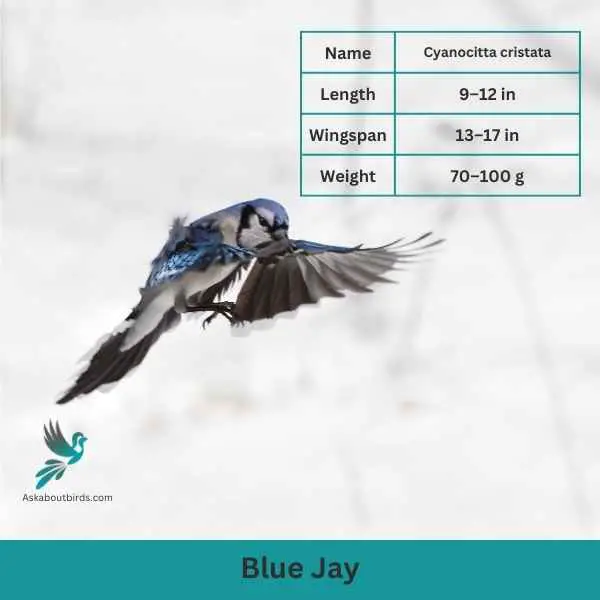
| Feature | Measurement |
|---|---|
| Scientific Name | Cyanocitta cristata |
| Length | 9–12 in |
| Wingspan | 13–17 in |
| Weight | 70–100 g |
The Blue Jay is a vibrant and easily recognized bird, known for its intelligence, distinctive calls, and bold behavior, commonly found throughout the eastern and central United States.
Appearance: The Blue Jay sports a striking blue upper body with white and black markings. Its face has a pronounced white patch with a black necklace that runs across the throat and around the head. The bird also features a pronounced blue crest, which can be raised or lowered, and its wings and tail are brightly colored with black bars and white tips.
Diet: Blue Jays are omnivores. Their diet consists primarily of seeds, nuts, especially acorns, fruits, and small insects. They’ve also been known to eat eggs or nestlings of other birds occasionally. Blue Jays often store food items in caches to eat later.
Reproduction: Blue Jays are monogamous birds that form long-lasting pair bonds. They typically build their nests in trees or large shrubs, constructing them from twigs, grass, and sometimes using mud as a binder. The female lays a clutch of 3 to 6 eggs, which are pale blue or sometimes white with brown speckles.
Barn Swallow


| Feature | Measurement |
|---|---|
| Scientific Name | Hirundo rustica |
| Length | 6.5–7.5 in |
| Wingspan | 12.5–13.5 in |
| Weight | 16–22 g |
The Barn Swallow is a sleek, agile bird renowned for its graceful flight patterns and iconic forked tail, often seen darting over fields and water bodies in search of flying insects.
Appearance: Barn Swallows have deep blue, almost iridescent, upperparts and a rufous to tawny underbelly. Their distinctively forked tail and long wings give them a streamlined look. Both males and females have a similar appearance, though males often exhibit slightly brighter colors and a deeper fork in the tail.
Diet: Barn Swallows feed primarily on flying insects, which they catch in mid-air during their agile and acrobatic flights. Their diet includes flies, beetles, moths, and other small flying insects.
Reproduction: Barn Swallows are known for building their mud nests on man-made structures, particularly barns, bridges, and eaves. The nest is cup-shaped and made from mud pellets, often lined with feathers. The female lays a clutch of 4 to 6 eggs.
Cliff Swallow
Scientific Name: Petrochelidon pyrrhonota
Length: 5-6 in (13-15 cm)
Wingspan: 11-12 in (28-30 cm)
Weight: 0.7-1 oz (20-28 g)
The Cliff Swallow is a small, agile bird known for its characteristic mud nests, social behavior, and long-distance migrations.
Appearance: Cliff Swallows have a distinctive appearance with a dark blue back, a cream-colored forehead, an orange-brown rump, and a buffy or whitish underbelly. They also have a square or slightly notched tail.
Diet: The diet of Cliff Swallows primarily consists of flying insects, including flies, beetles, and wasps, which they catch in the air while flying.
Reproduction: Cliff Swallows are known for building gourd-shaped mud nests, often in colonies on vertical cliff faces, bridges, or buildings. The female typically lays a clutch of 3 to 6 white eggs. Both parents participate in incubating the eggs and feeding the chicks.
Belted Kingfisher

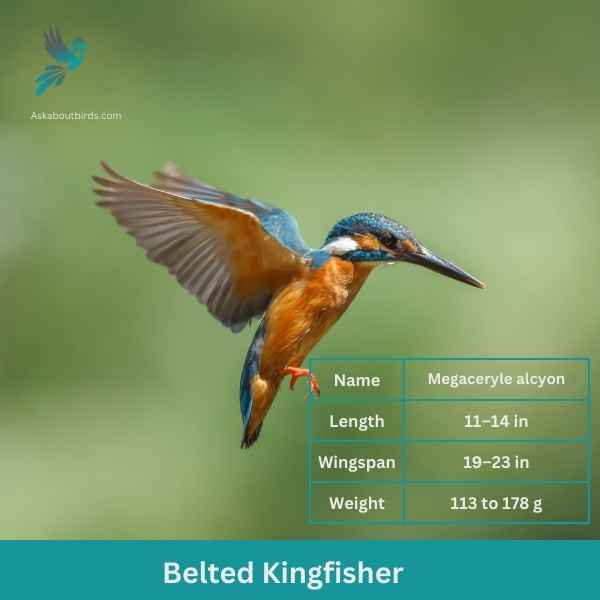
| Feature | Measurement |
|---|---|
| Scientific Name | Megaceryle alcyon |
| Length | 11–14 in |
| Wingspan | 19–23 in |
| Weight | 113 to 178 g |
The Belted Kingfisher is a distinctive and easily recognizable bird, frequently observed near water bodies, where it can be seen diving headfirst to catch prey.
Appearance: Sporting a prominent crest, the Belted Kingfisher has a slate blue-gray upper body and white underparts. Males possess a single blue band across their white chests, while females have an additional rufous band, making them one of the few bird species where females are more brightly colored than males. Their bill is long, sharp, and dagger-like.
Diet: As expert fishers, Belted Kingfishers mainly prey on small fish, but they’ll also consume crustaceans, insects, and amphibians. They’re known for their hunting tactic of hovering over water, spotting their prey, and then diving swiftly to snatch it.
Reproduction: Belted Kingfishers nest in burrows which they excavate in sandy or earthen banks, usually adjacent to water. The tunnel can be anywhere from 3 to 6 feet long, ending in a chamber. Within this chamber, the female lays a clutch of 5 to 8 white eggs.
Indigo Bunting


| Feature | Measurement |
|---|---|
| Scientific Name | Passerina cyanea |
| Length | 4.5–5.1 in |
| Wingspan | 7.1–9.1 in |
| Weight | 11.2–21.4 g |
The Indigo Bunting is a strikingly vibrant songbird, often hailed for its brilliant blue plumage and melodic song that graces woodlands and meadows during the warmer months.
Appearance: Males are renowned for their bright indigo blue feathers, which can appear darker in certain lights. Females and juveniles, on the other hand, are brown with subtle hints of blue on their wings and tail. The species lacks the vibrant streaking or spotting commonly found in many other songbirds.
Diet: Indigo Buntings primarily subsist on seeds, especially during non-breeding seasons. During the breeding season, they also consume a variety of insects such as beetles, caterpillars, and spiders, providing essential protein for their growing chicks.
Reproduction: Indigo Buntings build their nests close to the ground in shrubs or low tree branches. These nests, crafted meticulously with grasses and other plant materials, cradle clutches of typically 3 to 4 eggs. After hatching, the young are fed by both parents until they’re ready to fledge.
Tree Swallow
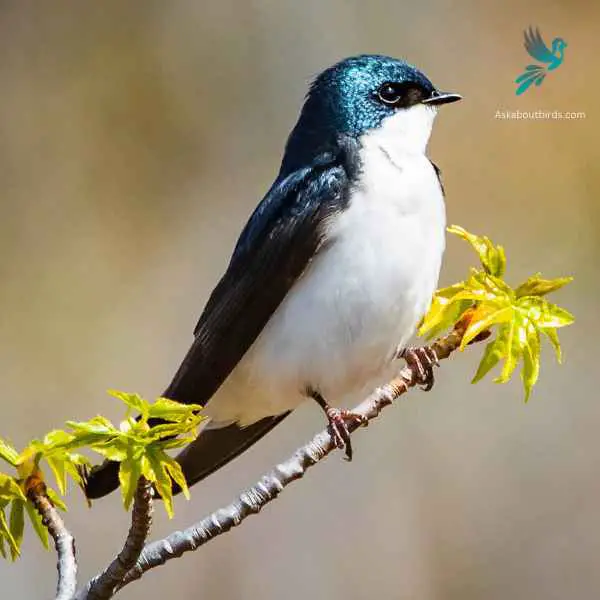
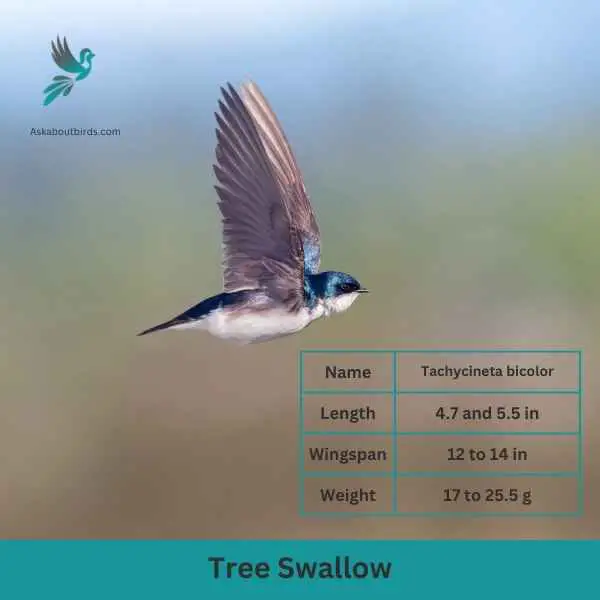
| Feature | Measurement |
|---|---|
| Scientific Name | Tachycineta bicolor |
| Length | 4.7 and 5.5 in |
| Wingspan | 12 to 14 in |
| Weight | 17 to 25.5 g |
The Tree Swallow is a graceful and agile bird, best recognized for its iridescent blue-green upperparts and sweeping flight patterns over open fields and water.
Appearance: The Tree Swallow is sleek with a streamlined body. The upperparts shine with a blue-green iridescence while the underparts are white. They possess long, pointed wings and a slightly forked tail, aiding in their agile flight.
Diet: Tree Swallows primarily feed on flying insects, skillfully catching them mid-air. During colder months when insects are scarce, they can switch to a diet of berries, particularly those of the bayberry, which other birds might find hard to digest.
Reproduction: Tree Swallows are cavity-nesters, typically choosing natural holes in trees or using bird boxes. They line their nests with feathers, creating a soft environment for the eggs. The female will lay a clutch of 4 to 7 white eggs.
Blue Grosbeak
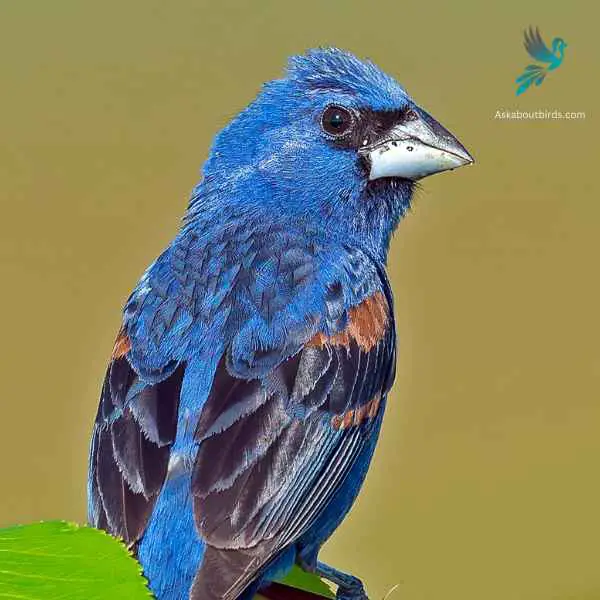

| Feature | Measurement |
|---|---|
| Scientific Name | Passerina caerulea |
| Length | 5.5 to 7.5 in |
| Wingspan | 10 to 11 in |
| Weight | 26 to 31.5 g |
The Blue Grosbeak is a medium-sized songbird found in North and Central America. The male Blue Grosbeak displays stunning plumage with deep blue feathers on its body and head, while the female has more subdued brownish tones. Both sexes have a thick, conical bill, which gives them their name “grosbeak,” meaning large beak.
These birds prefer open habitats such as grasslands, brushy areas, and woodland edges. Blue Grosbeaks are known for their melodious songs, which consist of a series of rich and varied notes. They primarily feed on seeds and insects, using their strong beaks to crack open seeds and forage on the ground or in low vegetation.
Eastern Bluebird
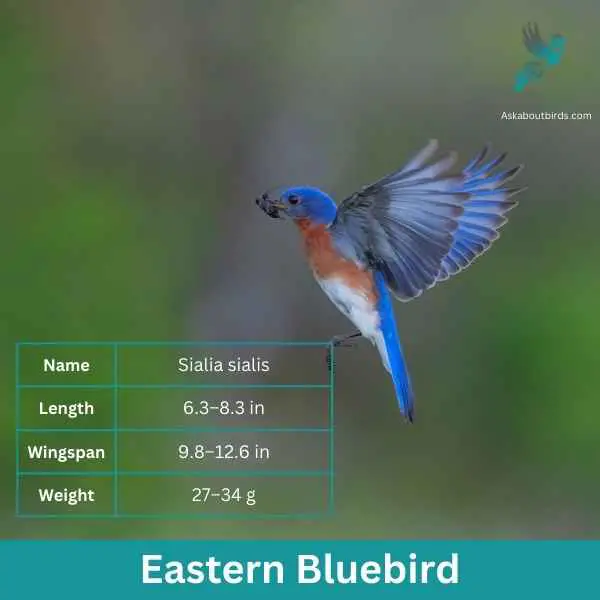
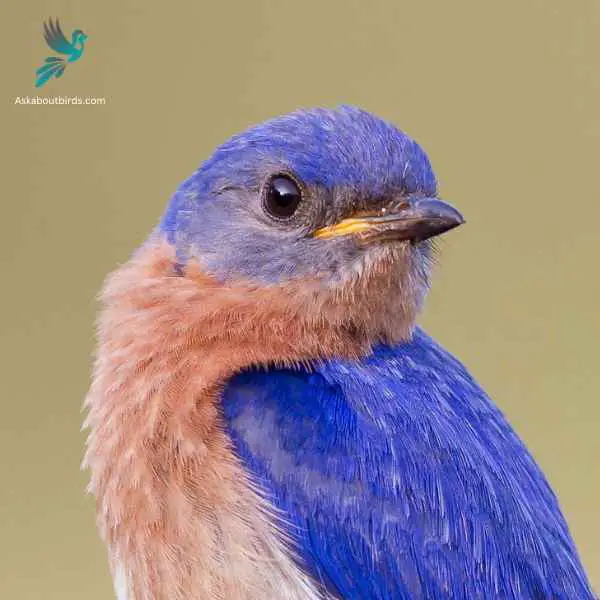
| Feature | Measurement |
|---|---|
| Scientific Name | Sialia sialis |
| Length | 6.3–8.3 in |
| Wingspan | 9.8–12.6 in |
| Weight | 27–34 g |
The Eastern Bluebird (Sialia sialis) is a small thrush found in open woodlands, farmlands, and orchards, and is recognized for its vibrant blue and red coloration. Male Eastern Bluebirds are dazzling with bright blue upperparts and a rusty or brick-red throat and breast, while females, though less colorful, still offer a similar pattern. The bird is native to North America and is commonly seen east of the Rockies, from Canada to the Gulf States and southeastern Arizona to Nicaragua.
Eastern Bluebirds feed on insects, wild fruit and berries. They have a gentle nature and are often seen perched alone or in small groups in the open, scanning the ground for prey. They are cavity nesters and will use old woodpecker holes or birdhouses if they are the right size.
Mountain Bluebird
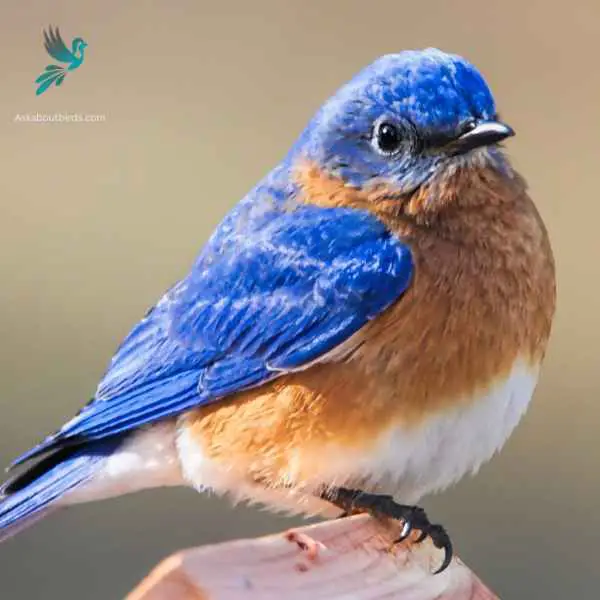
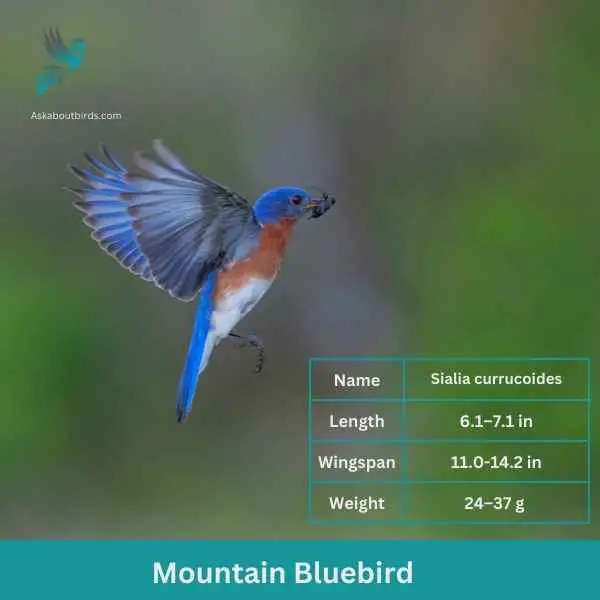
| Feature | Measurement |
|---|---|
| Scientific Name | Sialia currucoides |
| Length | 6.1–7.1 in |
| Wingspan | 11.0-14.2 in |
| Weight | 24–37 g |
The Mountain Bluebird is a small bird found in open grasslands and rocky mountains of North America. It is known for its stunning blue plumage, which is particularly vibrant in males. Females, on the other hand, have a more subdued blue coloration with hints of gray. These birds have slender bodies and a slightly curved bill, adapted for catching insects on the wing.
Mountain Bluebirds are insectivores, feeding primarily on insects such as beetles, grasshoppers, and spiders. They are skilled aerial hunters, capable of capturing their prey in mid-flight. During breeding season, these birds build their nests in tree cavities or man-made nest boxes, where females lay a clutch of eggs. The male bluebird actively participates in nest-building and provides food for the female during incubation.
Lazuli Bunting
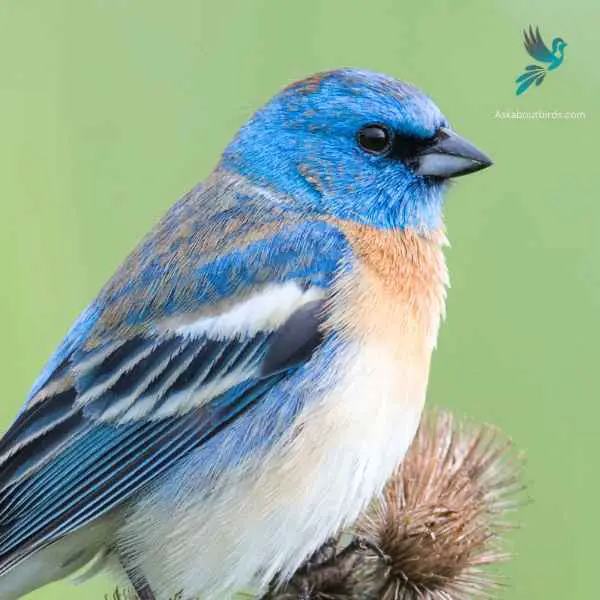

| Feature | Measurement |
|---|---|
| Scientific Name | Passerina amoena |
| Length | 5.1-5.9 in |
| Wingspan | 8.7 in |
| Weight | 13-18 g |
The Lazuli Bunting is a vibrant songbird recognized for its brilliant colors and melodious song, frequently seen in brushy areas and woodlands during the summer months.
Appearance: The male boasts a dazzling bright blue head and back, offset by a white belly and rust-orange breast. Females and immature birds present a more muted brownish hue overall, with a hint of blue on the wings and tail.
Diet: Lazuli Buntings primarily feed on seeds, but during the breeding season, they’ll also consume insects. Their strong, conical beaks are perfectly adapted for seed-cracking.
Reproduction: The female Lazuli Bunting constructs a cup-shaped nest using grasses, twigs, and other fine materials, often placing it in a shrub or low tree. She typically lays a clutch of 3-4 pale blue or white eggs.
Purple Martin
Scientific Name: Progne subis
Length: 7.5-9.1 in (19-23 cm)
Wingspan: 15.3-16.1 in (39-41 cm)
Weight: 1.9-2.3 oz (55-65 g)
The Purple Martin is a popular and widely recognized bird species, known for its acrobatic flight and social behavior.
Appearance: Purple Martins have a dark, glossy purple-blue plumage. Males are almost entirely dark purple while females and young birds have a lighter, greyish belly and throat.
Diet: The diet of Purple Martins primarily consists of flying insects such as beetles, flies, dragonflies, and moths. They catch their prey in mid-air while flying.
Reproduction: Purple Martins nest in colonies, often using artificial nest boxes provided by humans. The female typically lays a clutch of 4 to 6 white eggs, and both parents participate in incubating the eggs and feeding the chicks.
Little Blue Heron
Scientific Name: Egretta caerulea
Length: 22-29 in (56-74 cm)
Wingspan: 39-41 in (99-104 cm)
Weight: 12-14.5 oz (340-410 g)
The Little Blue Heron is a small, slender wading bird found in the Americas.
Appearance: Adults have a dark, slate-blue body and head, with a purplish neck and reddish-brown or maroon-brown throat. Immature birds are entirely white except for vague dusky tips on the outer primary feathers. The legs are greenish-yellow in juveniles and adults but change to dark during breeding season.
Diet: The Little Blue Heron feeds primarily on small fish, but its diet also includes insects, amphibians, and crustaceans. It typically hunts by wading slowly through shallow water and uses its sharp bill to capture its prey.
Reproduction: The Little Blue Heron breeds in colonies, often with other wading birds. The nest is a platform made of sticks, usually placed in trees or shrubs over water. The female lays a clutch of 3 to 5 pale blue or greenish eggs, which she incubates for about 22-24 days. Both parents feed the chicks, which fledge about 30 days after hatching.
Where to Spot North Dakota’s Blue Birds
North Dakota is a hidden gem for birdwatchers, boasting a rich variety of habitats that attract a wide array of bird species, including the mesmerizing blue birds. Here are the top locations in North Dakota known for the greatest diversity of birds:
- Theodore Roosevelt National Park: This national park is not only a tribute to a president who was a dedicated conservationist, but also a haven for birds. The park’s diverse habitats, from prairies to forests, attract a wide variety of bird species, making it a must-visit spot for birdwatchers.
- Lostwood National Wildlife Refuge: Located in the northwestern part of the state, this refuge is known for its grasslands that attract many species of birds, including the Baird’s Sparrow and Sprague’s Pipit.
- Chase Lake National Wildlife Refuge: This is one of the oldest national wildlife refuges in the United States and is home to one of the largest colonies of American White Pelicans. The diverse habitats here support a wide variety of bird species.
- Arrowwood National Wildlife Refuge: Located along the James River, this refuge offers a mix of wetlands, prairies, and forests, making it an ideal location for spotting a diverse range of birds.
- Lake Sakakawea: This is one of the largest man-made reservoirs in the United States, and its vast expanse of water attracts a variety of waterfowl and shorebirds. The surrounding areas also support many other bird species.
| Neighboring States | Best Spots for Blue Birds |
|---|---|
| South Dakota’s Blue Birds | 1. Custer State Park 2. Badlands National Park 3. Bear Butte State Park |
| Montana’s Blue Birds | 1. Glacier National Park 2. National Bison Range |
FAQs on Blue Bird Species Found in North Dakota
What should I provide as nesting material for House Sparrows?
House Sparrow nesting material is known to use a wide variety of materials to build their nests. Common materials include twigs, leaves, paper, and feathers. However, you can also provide them with straw, hay, or pine needles. It is best to provide a mix of materials and let the birds choose what they prefer. Avoid providing materials like plastic strips, yarn, or anything that could potentially harm the birds or their chicks. Remember, House Sparrows are cavity-nesting birds, so they will often build their nests in natural or artificial cavity, such as old woodpecker hole, building vent, or nest box.
What can I do to attract Red-Winged Blackbird to my yard?
Red-Winged Blackbirds are common to birding locations across North America and are usually found in scattered trees, wetlands, marshes, and areas with open water. However, they can also be attracted to your yard. Firstly, make sure you have a water source available, like a bird bath or a small pond. Secondly, Red-Winged Blackbirds are primarily omnivorous, and their diet includes insects, seeds, and grains. You can attract them by putting out bird feeders filled with black oil sunflower seeds, cracked corn, and other grains. Additionally, planting native plants that attract mostly insects can also help since they eat insects. Finally, providing backyard birds a nesting location with tall reeds or grasses can also encourage these blue beauties to stay.
What are the differences between western bluebirds and other bluebird species?
Western bluebirds are one of the three species of bluebirds found in North America. For bird identification, they have a bright blue plumage on their head and back, which is a key characteristic of all bluebird species, but the western bluebirds have a rusty-orange chest and a pale brown belly. The eastern bluebird’s tiny body has a bright red-orange chest, while the mountain bluebird is mostly bluish-gray with a lighter belly. The range maps and habitat preferences also vary among the bluebird species, with western bluebirds being found mainly in the western half of the continent.
How can I attract Ruby-Throated Hummingbirds to my garden?
The Ruby-Throated Hummingbird is the only species of hummingbird that breeds in the eastern half of North America. To attract these beautiful birds to the bird feeder in your garden, start by planting native plants that produce nectar-rich flowers. Hummingbirds are particularly attracted to bright red, orange, or pink tubular flowers, as they can easily access the nectar with their long tongues. Additionally, you can also set up hummingbird feeders filled with a mixture of sugar water (1 part sugar to 4 parts water). Make sure to clean the feeders regularly to prevent the growth of harmful bacteria and mold. Also, provide a water source for them to bathe and drink from. Avoid using pesticides in your garden as hummingbirds also eat insects and spiders for protein, and pesticides can be harmful to them.

